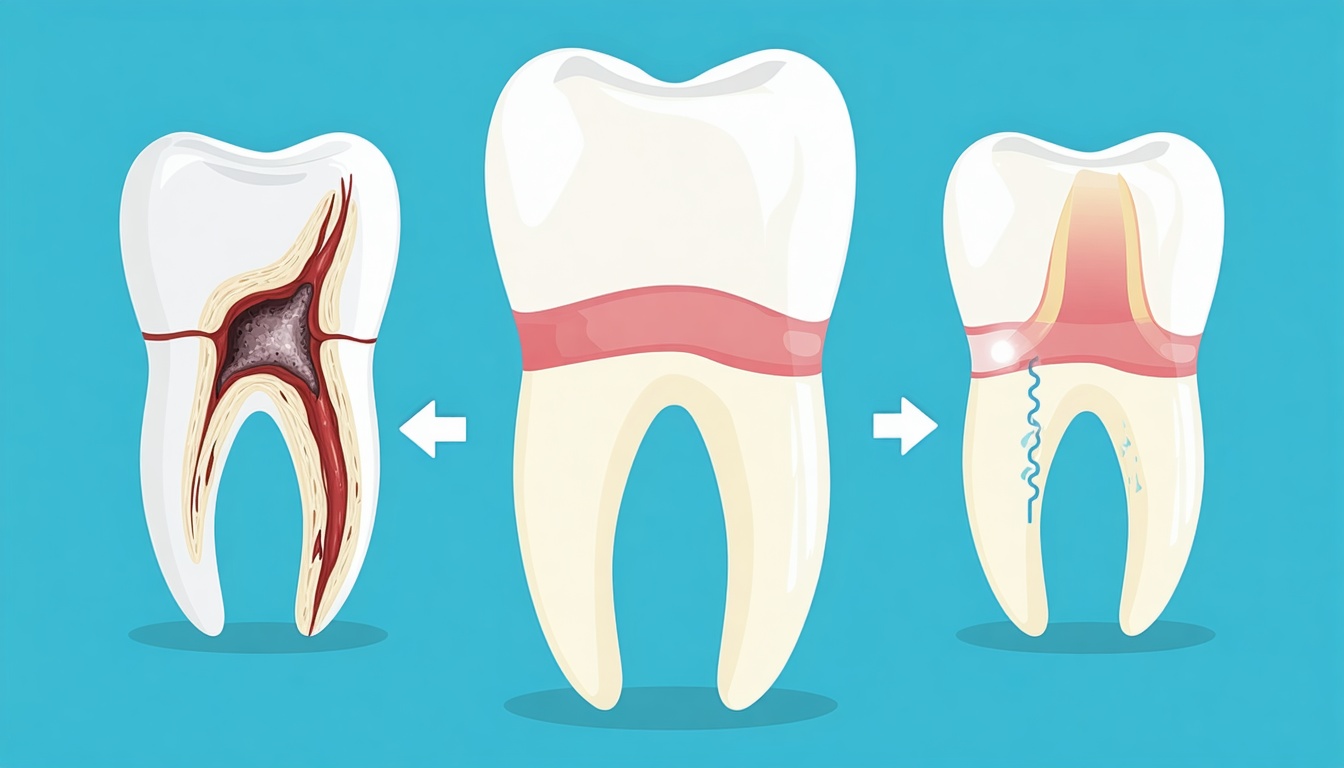Signs You Need a Root Canal
If you’re experiencing persistent tooth pain, sensitivity, or other discomforts, it’s essential to recognize the signs that may indicate you need a root canal. Understanding these symptoms can help you take timely action to preserve your dental health.
Recognizing the Symptoms
Common signs you may need a root canal include:
- Tooth Pain: Persistent or severe pain in the affected tooth can indicate infection in the pulp.
- Sensitivity to Temperature: Prolonged sensitivity to hot or cold beverages can suggest a damaged nerve.
- Pain When Chewing: Discomfort or pain when biting down or chewing may signal the need for treatment.
- Swelling or Tenderness: Swelling in the gums near the affected tooth or tenderness can indicate an underlying infection.
- Gum Boil: A boil on the gums can be a significant sign of pus accumulation due to an infection Cleveland Clinic.
| Symptoms | Description |
|---|---|
| Tooth Pain | Persistent or severe discomfort in the tooth |
| Sensitivity | Prolonged sensitivity to hot or cold |
| Chewing Pain | Discomfort when biting down |
| Swelling | Tenderness or swelling in the gums |
| Gum Boil | Pus accumulation indicated by a boil |
If you’re experiencing any of these symptoms, it’s important to see your dentist as soon as possible. Timely treatment can relieve pain, save the tooth, and prevent the infection from spreading.
Importance of Timely Evaluation
Acting swiftly when you notice symptoms of a possible root canal can make a significant difference in your treatment outcomes. Delaying evaluation and treatment can lead to further complications, including chronic infections that could affect your overall well-being. Chronic oral infections have been linked to systemic health issues such as heart disease and diabetes, compromising your immune system and making you more susceptible to other health problems (Southwest Endodontics).
Moreover, neglecting necessary procedures can result in tooth loss. As infection progresses, it may damage the surrounding bone and lead to tooth degradation, potentially requiring extraction (Southwest Endodontics). To gain a better understanding of what happens during the procedure, you can find detailed information in our article on what is root canal treatment.
Being proactive about your dental health not only preserves your natural teeth but also contributes to your overall health. If you’re unsure about whether you need a root canal, consult with your dentist for a thorough evaluation, which may include X-rays to assess the extent of any damage or infection.
Understanding Root Canal Treatment
Purpose and Procedure
Root canal treatment is designed to save your tooth by removing infected pulp from the inside of the tooth, cleaning and enlarging the root canal, and then filling it with appropriate material. The process begins with an evaluation and diagnosis, often indicated by persistent pain or sensitivity, which are clear signs you need a root canal.
The procedure typically includes the following steps:
- Anesthesia: Local anesthesia is administered to numb the affected area.
- Access Opening: A small opening is made in the crown of the tooth to reach the pulp chamber.
- Pulp Removal: The infected pulp is carefully removed.
- Cleaning: The inside of the tooth is cleaned and shaped to prepare for filling.
- Filling: The hollowed space is filled with a biocompatible material to seal the tooth and prevent reinfection.
- Sealing: An access hole may be sealed or a crown placed to protect the tooth. Crowns can be made from various materials, such as porcelain or metal (NHS).
| Step | Description |
|---|---|
| 1. Anesthesia | Numbing the affected area |
| 2. Access Opening | Creating a small opening in the tooth |
| 3. Pulp Removal | Extracting infected pulp |
| 4. Cleaning | Preparing the canal for filling |
| 5. Filling | Sealing with biocompatible material |
| 6. Sealing | Closing access hole or placing a crown |
Success Rate and Longevity
Root canal treatment boasts a high success rate in preserving your tooth and alleviating infection symptoms. Approximately 9 out of 10 root-treated teeth survive for 8 to 10 years, especially when a crown is placed afterward.
To put this in perspective, the success rate of traditional root canal therapy ranges from 85% to 97%, depending on the extent of tooth damage. Even if reinfection occurs, the procedure can often be redone or a small operation, such as an apicoectomy, can be performed to address the issue.
Overall, most root canal procedures are successful and can potentially last a lifetime. They prevent the spread of infection and offer a means of pain relief, making them a viable option for those looking to avoid tooth extraction. For more information about the treatment process, check our resources on what is root canal treatment and root canal procedure steps.
Benefits of Root Canal Therapy
Root canal therapy is a vital dental procedure aimed at preserving your natural teeth and preventing further oral health complications. Understanding the benefits of this treatment can provide you with confidence in seeking the appropriate care for your dental needs.
Tooth Preservation Advantages
One of the primary advantages of root canal therapy is the preservation of your natural tooth. Each year, more than 15 million teeth are treated and saved through this common procedure (American Association of Endodontists). By addressing the infection or damage within the tooth’s pulp, this treatment alleviates pain and restores the tooth’s function.
Consider the following comparison of tooth preservation methods:
| Procedure | Preservation Rate | Lifespan of Solution |
|---|---|---|
| Root Canal Treatment | Over 90% | Many years to a lifetime |
| Tooth Extraction | 0% | None |
Choosing root canal therapy enhances your chances of keeping a natural tooth, which is crucial for maintaining proper alignment of remaining teeth and supporting overall oral health. For more detailed insights into what a root canal involves, check out what is a root canal.
Prevention of Infection Spread
Another significant benefit of root canal treatment is the prevention of infection spread. When left untreated, an infected tooth may lead to severe pain and potentially hazardous complications, including abscess formation or systemic infections. Treating a severely infected tooth promptly prevents the infection from spreading to surrounding teeth and tissues (Spring Dental Associates).
Delaying treatment may result in unbearable pain affecting daily routines like eating and sleeping (54th Street Dental). By opting for a root canal, you not only relieve immediate discomfort but also protect your overall health.
If you’re experiencing symptoms such as persistent tooth pain, sensitivity, or swelling, it may be time to schedule an evaluation to determine if you need a root canal. Remember that timely intervention is essential, as it ultimately leads to more efficient and less invasive dental care. For further guidance on what to expect, you can learn about what is root canal treatment and the typical root canal procedure steps.
Recovery After Root Canal
Undergoing a root canal treatment is a crucial step in preserving your natural tooth and alleviating the pain associated with dental infections. Understanding what to expect during recovery can help you navigate this process with confidence.
Typical Duration and Sensitivity
Recovery from a root canal typically takes less than a week. Most patients experience only mild sensitivity during this period, particularly right after the numbness wears off. This sensitivity usually lasts about 24 hours and is a result of general irritation caused by the treatment, rather than issues with the tooth itself. It is essential to monitor any lingering pain beyond this timeframe, as it should be reported to your healthcare provider.
| Recovery Stage | Duration | Sensitivity Level |
|---|---|---|
| Immediate Post-Procedure | 1-2 hours | Numbness from anesthesia |
| First 24 Hours | Sensitivity Present | Mild discomfort expected |
| 2-7 Days | Recovery Period | Gradual decrease in sensitivity |
Post-Treatment Care Tips
Proper aftercare following your root canal is essential to ensure effective healing and lessen discomfort. Here are some key tips to follow:
- Follow Your Dentist’s Instructions: Adhere closely to any post-procedure guidelines provided by your dentist, including medication schedules and oral care tips.
- Pain Management: Over-the-counter pain relievers, such as ibuprofen or acetaminophen, can be used to alleviate mild discomfort. Consult your dentist for recommendations on pain relief.
- Diet Modifications: Stick to soft foods for the first few days to avoid putting pressure on the treated tooth. Gradually reintroduce your regular diet as comfort allows.
- Oral Hygiene: Maintain diligent oral hygiene, but be gentle around the treated area. Avoid vigorous brushing and flossing until your dentist advises you otherwise.
- Follow-Up Appointments: Ensure you schedule any necessary follow-up visits to monitor healing and discuss options for tooth restoration, such as crowns (what is root canal treatment).
By understanding the typical recovery timeline and following these care tips, you can effectively manage your healing process after a root canal. If you notice persistent pain or sensitivity, don’t hesitate to reach out to your dental professional for further evaluation. For more information on what to expect during recovery, visit our article on root canal recovery time.
Consequences of Avoiding Root Canal
Avoiding a much-needed root canal can lead to significant adverse effects on your dental health. Understanding the consequences of delaying this treatment is essential for preserving your natural teeth and preventing further complications.
Pain Escalation and Infection Spread
One immediate consequence of postponing a root canal is the escalation of pain. What may begin as mild sensitivity can quickly intensify into severe, throbbing pain as the infection worsens. Many individuals who delay treatment find themselves seeking emergency care due to unbearable discomfort, which could have been prevented with timely intervention.
Furthermore, the spread of infection is a critical concern. If left untreated, the infection inside the tooth can extend to surrounding tissues, potentially leading to an abscess. An abscess can manifest with symptoms such as swelling, tenderness, and even fever. In severe cases, the infection may transfer to other body parts, including the jaw, neck, or bloodstream, resulting in life-threatening conditions like sepsis (Southwest Endodontics).
Tooth Loss and Impact on Overall Health
Delaying a root canal significantly increases the risk of tooth loss. As the infection progresses, it can damage the surrounding bone that supports the tooth, leading to bone degradation. Over time, the affected tooth may become loose and ultimately require extraction. This loss not only affects the aesthetic quality of your smile but can also disrupt the alignment of your remaining teeth, leading to bite issues and difficulties with chewing (Southwest Endodontics).
Additionally, neglecting dental infections can adversely impact your overall health. Chronic infection and inflammation in the mouth have been linked to various systemic health conditions, including heart disease, diabetes, and respiratory infections. Untreated dental issues can weaken your immune system, making you more susceptible to other health challenges.
In the face of persistent tooth pain, sensitivity, or signs of infection, recognizing the signs you need a root canal and seeking prompt treatment can prevent these serious consequences. Do not hesitate to consult your dentist to address any dental discomfort and safeguard your long-term health.
Exploring Holistic Alternatives
When faced with the decision about whether to undergo a root canal, some individuals may consider holistic alternatives. These options aim to support dental health while minimizing invasive interventions.
Procedures and Philosophies
Holistic dentistry offers various alternatives to traditional root canal therapy. Some of these include:
- Tooth Extraction with Advanced Techniques: This method goes beyond standard extraction, implementing advanced strategies to promote healing and restore oral health.
- Zirconia Implants: These biocompatible implants can replace extracted teeth, providing a natural look and feel.
- Calcium Hydroxide Treatments: Used as an intra-canal treatment, calcium hydroxide helps in managing infections and promoting healing.
- Ozone Therapy: This involves irrigating the tooth cavity with ozone gas, which has antimicrobial properties that can assist in eliminating infection.
- GentleWave® Procedure: A minimally invasive option that utilizes sound waves to clean the root canal system effectively.
- Direct and Indirect Pulp Capping: These techniques aim to preserve the tooth’s pulp by covering it with a material that protects and encourages healing.
These options are designed to address dental concerns while aligning with a holistic approach that considers overall health and well-being (Aria Dental Care).
Considerations for Treatment Choices
Before deciding on a treatment option, consider the following:
- Consultation: Engage with both conventional and holistic dental practitioners. Understanding all available options enables you to make informed choices regarding your dental care.
- Personal Health Goals: Define what you aim to achieve through treatment. Whether preserving natural teeth or seeking alternative therapies, your goals should guide your decision-making.
- Long-Term Well-being: The ultimate aim of any dental intervention should be to enhance your overall health and ensure your teeth and gums remain healthy for years to come.
By exploring these holistic alternatives and understanding their philosophies, you can make educated decisions that best suit your needs. For further information on conventional procedures, you may want to read about the root canal procedure steps or the root canal vs tooth extraction comparisons.










